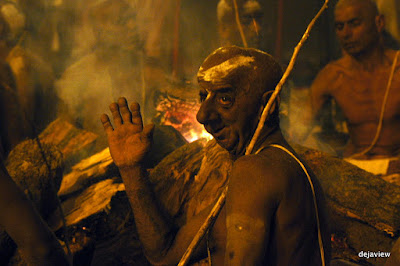Theyyam (or Thira) is a popular ritual form of worship of North Malabar in Kerala, India, predominant in the Kolathunadu area as a living cult with several thousand-year-old traditions, rituals and customs. The performers of Theyyam belong to the lower class community, and have an important position in Theyyam. People of these districts consider Theyyam itself as a God and they seek blessings from this Theyyam. The invocation is generally performed in front of the village Shrine. It is also performed in the houses as ancestor-worship with elaborate rites and rituals.
Tears profusely gushed down my face as I battled to watch Goddess Annapoorneshwari‘s captivating invocation at a tucked away shrine in Azhikode. I had heard about Theyyam just a month back only to find myself amidst meticulously clad avatars of God.
Before this I had not even visited the green and thickly cultured side of Kerala and hence, Kannur was my first experience in many ways. I took my own time to absorb the atmosphere; I couldn’t get what all the huff-puff was about? What was it about the Theyyam stories and invoking God within oneself? Why was only a particular sect of the community allowed to don the role of a God? By the time I reached the Ram temple of Andaloor, where a gathering of possibly 3-4 village folks increased my curiosity and the list of questions? It slowly unfurled as the noon turned into evening and the temple turned into spectacle – in the eyes of worshippers, in their body language, in their hope and prayers, in their togetherness, in the eyes of the man who was going to turn in to God soon, in his body language, in his hope and prayers. It seemed like what was holding them together was what they had been through. Getting groped by a crowd full of hairy men, clad in their vests and mundus, wasn’t the kind of first-time experience I expected to add to my list. What I did add though was the sight and change in air with the entry of the man who donned the avatar of God Ram.
I had never understood devotion; I thought like love, it is blind, blind faith, blind expectations and blind logics. My list got added as one after another, our Auto-man, Aari, informed us about possible Theyyams happening around the town. And then I finally reached the shrine at Azhikode. I think I still haven’t understood devotion but besides witness it in abundance something did stir in me, some voice did speak to me, some touch did awaken me and I looked around. All around I could only see God Annapoorneshwari’s invocation and her presence, in a man who transformed himself to the Goddess, the Goddess who transformed people’s lives even if it meant for a bit. And when she touched my forehead to tell me “I had got nothing to worry, it will all happen in good time” she transformed my list of first time experiences into list of blind faith, expectation, logic and devotion.
In Theyyam I saw how a man took on the role of Goddesses to bear the pain a woman does and to share back the strength she provides to us and yet, for those moments when her man is has God within, she shrinks and awaits for him to return, just as I do to build my list. Again.
















